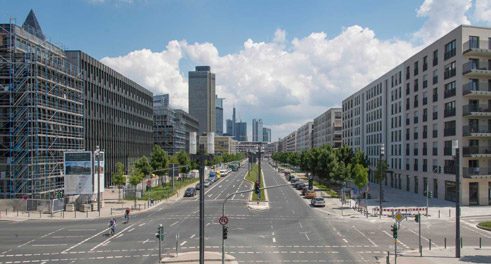Life in metropolises
The new urban allure

The image of the city has seldom been so good as it is today: more and more young families and also senior citizens want to enjoy the advantages of a metropolis. Many cities have responded to this demand with ambitious housing programmes.
In the first report that the Foundation for Building Culture presented to the German federal government at the end of 2014, there is a map of internal German migration. Shrinking cities are marked with a red spot, growing ones with a black spot. The resultant map of Germany shows a large triangle of chickenpox representing waning communities, stretching from the Ruhr area in the west up to Rügen on the Baltic Sea, and from there down to Saxony and over northern Hesse back to the Ruhr. Apart from a few islands of black such as Berlin, Leipzig and Dresden, eastern and central Germany is dotted solid in red. The north and the south, on the other hand, are massively black. Especially metropolitan regions such as Hamburg, Munich, Stuttgart and Frankfurt am Main magnetically attract the removal vans. The trend is very clear: while Germany’s total population has been shrinking since 2003, mass migration from the countryside to the metropolis has favoured about a dozen cities.
What is actually happening here? Why are young families, who twenty years ago were eager to move to the country and there into their catalogue house, now moving back to the city? Why are the elderly increasingly opting to enjoy the advantages of big cities? And how is it that just the former workers’ paradises, whether cities in the east or industrial districts in the west, are today threatened with extinction?
Rural exodus of the qualified
Chiefly responsible for the monitory red triangle of shrinking cities is certainly moribund industrial heritage and missed structural change. But a recent study by the Berlin Institute for Population and Development names a perhaps still more important dynamics: the ever-increasing number of young people with school-leaving examinations in medium-size and small towns has led to their seeing their future not in the countryside but rather in seeking better jobs in the big cities. But the luck of the talented is the misfortune of the elderly. For those left behind, the rural exodus of the qualified sets in motion a spiral of rising age and dwindling services. The fewer the people and the less the income that remains in the sprawling world of one family houses, suburbs and small towns, the more rapidly public services deteriorate. Fewer doctors, bus lines, bakers, schools and kindergartens lead to ever greater distances that have to be travelled by car.Investing in attractive residential quarters
It is exactly this that makes life in the prosperous towns of the urban fringe especially unattractive for families. If even the 20 hours spent in commuting by car every week to manage work, household and parent-teacher conferences are not enough, then the reversal of life in the country to life on asphalt puts paid to the dream. This was not how commuters imagined the good life. And the big cities, which since Konrad Adenauer’s building society policy have suffered the departure of homeowners to the environs where they pay their taxes, have now learned their lesson. Investing in mixed residential quarters in former harbour, railway and barracks areas, in cultural centres and urban greenery, in shopping and sports areas, has paid off for those cities which have banked on urban density and the qualitative improvement of the living environment since the 1990s. The image of the city has seldom been so good, its benefits seldom so convincing.The new urban allure, however, will remain attractive only as long as the mixed calculation of time and money is heeded. For the one family house is still the Germans’ preferred form of living. Nevertheless, many people are willing to live in cities in order to save time. When urban rents become painfully dear, however, the daily commute back to the suburbs appears to be the less evil. Especially in cities such as Hamburg and Munich, the mismatch between supply and demand has led to so overheated a rental rate that the urban air makes the newcomer poor rather than free. This is why most big cities have recently launched extensive housing programmes, of which that of the Bavarian capital, with a planned 100,000 new units, is the most ambitious.